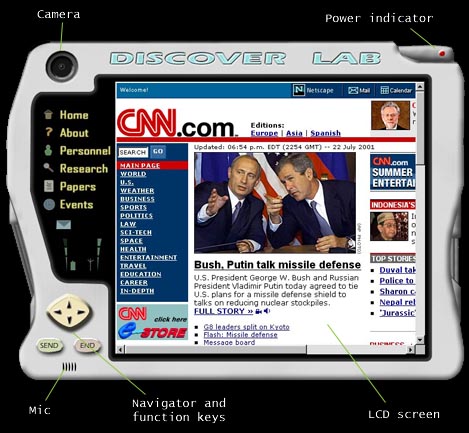|
The Laboratory of Digital Signal Compression & Video Encoding Research, or DISCOVER Lab for short, is a research facility for video/audio compression algorithm development aiming at elevating worldwide workstation video capability to the status of a standard utility. The lab is under the direction of Professor Toby Berger of the School of Electrical and Computer Engineering and Center for Applied Mathematics, at Cornell University. Since DISCOVER Lab was founded in 1994 by Prof. Berger and Dr. Ahmad Bou-Shehri, the main area of our research has been in desktop video-conferencing systems and very low bit rate video-phone systems. In recent years, we have expanded our scope to include the wireless enabling and deployment of these systems on handheld computing devices, and open source development of our video conferencing software on the Linux platform. Our lab is also involved in research projects concerning human signature verification, speaker verification, and various aspects of IEEE 802.11 wireless networking. Presently, there are also plans to work with BREW, Qualcomm´s platform for 3G cellular networks, to develop video-enhanced handsets. For details on present and past research projects, please see below and sections under "Research" and "Papers"
|
|||
|
It is based on the papers " Perceptual Considerations in Spatial- temporal Video Compression" and "Facsimile-Based Video Compression" by Yi-Jen Chiu and Toby Berger. Using spatio- temporal compression techniques for perceptual coding, the algorithm is able to capitalize on limitations in the human visual system to greatly improve the tradeoff between data rate, picture quality, computational complexity and latency. Contrasting with traditonal algorithms that adjust the quantization factors in frequency domain compression to temporarily provide lower-quality pictures during network congestions or intense object movements, our scheme restrain bitrate by compressing picture information in ways that are visually indistinguishable to human perception.Development of a MS Windows based video conferencing software of the same name that applies this algorithm has constantly been our main research and development focus. In recent years, we have also successfully started a parallel development on the Linux platform with an open source project called qVIX/CU30. Although the core of this application is based on CU30, the latest version incorporates fruitions of various R&D efforts from past years, such as object tracking, motion compensation and codebook generation techniques. The CU30 algorithm are covered under US patents 5,740,278 and 5,973,626. With the advent of our Linux development, in Dec 2000 the Cornell Research Foundation grants the Free Software community free use of CU30 and qVIX under the GNU General Public License. For more details on projects relating to CU30, please visit the " Research" section and our SourceForge homepage.
|
|||||||||||||||||||||
|
qVIX/CU30 is our open source video conferencing project on the Linux platform. qVIX, which unofficially stands for Quintessential VIdeo eXperience, is basically a set of wrapper code of the Windows based CU30 software and the GUI front-end for Linux desktops.
Recently, the OpenH323 project that is developing an open source implementation of the H.323 protocol suite has opted to include our CU30 codec in their specifications. Thus, in the future any software that uses the OpenH323 stack to process video and audio bit formatting will need to provide support for our video codec as well. One such example is a free software called GnomeMeeting that is designing a H.323 compatible client (or in other words a clone of MS NetMeeting) for the Gnome desktop. From becoming a part of OpenH323, we can leverage existing video conferencing software to provide interfaces for our video codec and thus freeing us to focus our research and development efforts on our algorithm.Anyone who is interested to participate is encouraged to visit our project homepage on SourceForge.com. For more details on projects relating to qVIX, please visit the " Research" section and our SourceForge homepage.
|
|||||||||||||||||||||
|
You have seen or heard of them in ads, movies, promotions at trade shows..., wireless handheld devices will soon be everywhere. We will be jotting down memos on them rather than paper, surfing the web wherever we are, making phone calls anytime, and most of all, video conferencing with people around the globe on them! Yes, pervasive computing is coming to our palms soon! |
|||
 |
|
Actually we are not that far away from the future at all, one of our lab's current projects is dealing with enabling single board computers with wireless networking capabilities for video conferencing. |
|
|
|
|
All graphics unless specified below, uncredited photos, and design of this website are original work of Douglas Chan. Their copyrights belong to DISCOVER Lab. Icons at the bottom of Home page (except "CE") are graphics taken from the respective websites that they link to. BREW graphic in Research page was taken from Qualcomm´s BREW website. Web page graphic appearing in handheld device above was taken from CNN.com. Credits for photos are listed besides each of them. |
 |
||||||||||
|
©Copyright 2001 DISCOVER Lab |
||||||||||